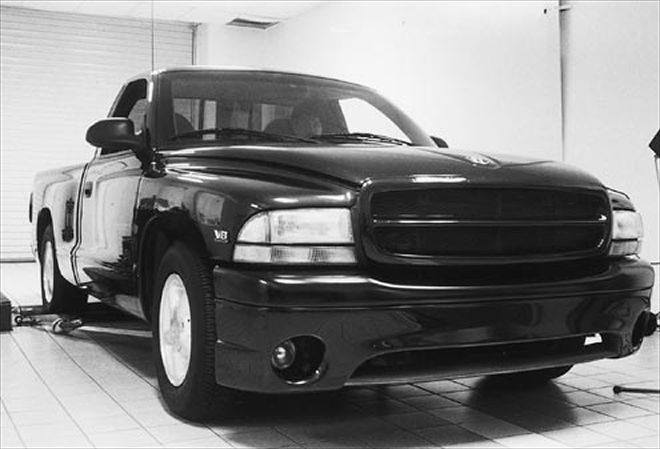

One of the easiest ways to tune your engine’s power is by adjusting the ignition timing. Usually, most normally aspirated engines can stand to use a little more advance in the timing curve, while supercharger applications require a bit of retard. This is all fairly basic motorhead stuff that guys have been doing since the Dodge Brothers first started turning wrenches. However, with the advent of onboard computers and electronic engine management, most of the standard tune-in-your-driveway techniques are no longer just a reach for a distributor wrench. For anybody who has a ’96-or-newer OBDII- (On Board Diagnostics II) equipped Magnum truck, the options have been limited. At least OBDI (On Board Diagnostics I) has been around long enough that the aftermarket has learned how to tune it with new computer chips and piggyback modules. But with OBDII, there is no real way to change the timing—or anything else for that matter—short of going with the OE manufacturer’s hot replacement computer.
The problem with the hotter computer is that it’s set up to work within a fixed set of parameters, then is locked in to those parameters. You buy it, bolt it in, hook it up, and go. Step out of what the manufacturer felt was the ideal package when it was programmed, and you’re in no-man’s-land.
Problems frequently incurred with the OE hi-po electronic control modules include the addition of nitrous or a blower. The hot programs take into account new cams, maybe higher compression, headers, and so on, but they don’t think about setting up the computer for the boosted atmosphere that blowers and nitrous present. As we’ve stated, some advance usually is desirable to make more power. As a result, the hotter computer has a more aggressive advance curve built into it. But with a blower or nitrous, you want the timing to be retarded. We know more than a few people who have lifted head gaskets by running the hotter computer with a blower, due to detonation. With the potential for damage with detonation on a blower application, they’re lucky all they did was blow head gaskets. Throw nitrous anywhere into the equation, and things can get real ugly. That’s why if you are going to run a blower with OBDII, it’s generally recommended that you stick with the stock computer to avoid most of the detonation problems, though you should still be wary of it in all cases.
Pat Stajdel at Superchips called us one day and asked if we knew anyone who owned an OBDII vehicle with a blower on it, because they were working with Vortech Superchargers on a timing control module for ignition retard to eliminate those detonation problems. We didn’t know anybody, but got to thinking that if they can retard the timing for a blower, could they advance the timing for nonblower applications? Pat liked the idea a lot, so we drove our Dakota over to their shop in Longwood, Florida, to do a little R&D on their chassis dyno.
Their module is called the Icon Race, and it works by intercepting the signals between the computer and the coil, then resending it to the coil at a programmed rate. Because the Icon picks up the signal after the vehicle’s computer does, the computer doesn’t even know it’s there. Not only is Icon infinitely adjustable, but you can also set retard and advance throughout the entire RPM band in ½-degree increments. The added advance is in addition to the advance already set in the stock computer. Because it is completely programmable with a laptop, you can do cool things, such as ramp the curve up to 8 degrees through 4,500 rpm, then pump it up another 2 degrees through 6,000. You can also back it down a couple of degrees at the shift points. The great thing about this is that you can play with the timing on the computer graph and get rid of any spikes and valleys in the powerband. Because the vehicle is tuned on their chassis dyno, you can dial it in from idle to redline. We found that our relatively stock (only headers and exhaust modifications) Dakota liked 9 degrees more advance than what the vehicle’s computer has, which turned out to be good for almost 20 lb-ft of torque at the rear wheels!
The module installs quite easily, with the only leads being a keyed 12V power source, a ground, and a pair of wires that intercept the signal at the coil. The Icon also can be quickly disconnected, should the need arise. Right now, the module is in the “For Off-Highway Use” category, because it hasn’t proceeded through the Executive Order process, required by the California Air Resources Board. This procedure is tantamount in the automotive aftermarket, as well as emissions-legal in all U.S. jurisdictions. Also, we don’t know how Chrysler feels about the module, as far as the factory warranty is concerned.
If you’re running a blower, the little Icon Race box is the least of your concerns in regards to the warranty. Our 3-year/36,000-mile warranty actually expired on the way to Longwood, Florida, so we’re on our own now, anyway. Superchips has franchises throughout the country, so this isn’t something that only magazine guys have access to. Most of the shops have a chassis dyno, but if you can’t find one near you, Superchips can supply you with a program for your laptop, and you can spend a day at the track dialing it in. Give them a call to find the dealer nearest you.